Dispelling Myths: SCR and DEF simplicity in the Oil & Gas market
By Katie Yoder, Marketing Communications Specialist

Selective Catalytic Reduction (SCR) systems are not a new concept in every industry. The emissions regulation option first appeared in the on-highway space in 2012 and is slowly creeping into the industrial spaces. In the Oil & Gas industry, Cummins has made the switch to supporting EPA Tier 4 emissions standards by implementing SCR systems.
But making this advancement in such a mature industry can be a big change for both manufacturers and for customers. When the products have looked, operated, and felt the same way for decades, a change like this one can seem to disrupt daily functions. However, Cummins is here to dispel any myths or misunderstandings about SCR systems that could make customers weary about this newer technology.
First, why are SCR systems that require Diesel Exhaust Fluid necessary?
Without getting too technical, EPA Tier 4 emissions standards for Oil & Gas applications that provide 700hp or less require a chemical reaction that only SCR systems can support. SCR systems operate as an aftertreatment system that reduces the emissions produced from the engine. This is done through a chemical reaction completed within the tank that requires diesel exhaust fluid (DEF). Essentially, the exhaust enters the SCR system and, when combined with DEF, removes the carbon monoxide from the fumes and emits a fraction of the emissions that would occur without the aftertreatment system.
Okay, what kind of system is the SCR replacing?
The alternative to an SCR system is an Exhaust Gas Recirculation (EGR) system. EGR options also act as an aftertreatment system to strip the exhaust of carbon monoxide and therefore reducing emissions. However, the EGR process cannot clean the fumes produced by an engine enough to meet EPA Tier 4 standards at rating below 700hp. At the moment, EPA Tier 4 requirements are only in place for products 700hp or less so EGR systems are still a viable market option above this horsepower range.
What is DEF and why is it required for SCR and not EGR?
DEF is a solution used with SCR systems in order to spark the chemical reaction that strips exhaust fumes of higher levels of carbon monoxide. This solution is what allows businesses to meet the more stringent emissions requirements that EGR systems cannot currently accommodate.
Does requiring DEF for my SCR system create more complexity in my application and is it more expensive?
No, SCR systems that use DEF are not more complex, require little to no extra effort and will not cost you more money in the long run.
DEF tanks come in various sizes to accommodate your operation. Whether that is a shift change after 12 hours, or between frac stages to be refilled if necessary, so as not to interrupt the any sequences of your operation. This event becomes seamless once it is introduced and your employees become fully trained.

SCR systems are not only better for the environment, but in the long run they are a more cost-efficient investment. The engines run cooler, achieve better fuel consumption rates and don’t require midlife overhaul injection changes. Even if you consider the price of DEF per gallon, Cummins SCR system is more economical than most competitor products on the market.
Are there downsides to using DEF in SCR systems?
The largest drawback to using DEF is that the solution can freeze, which doesn’t exactly make it optimal for cold weather conditions. However, the DEF that is actually in the units during operation has a thermal system to ensure the solution maintains its liquid state. Additionally, for the DEF storage that will be on-site, related industries are creating pieces that can be placed at the location to keep DEF thawed.
In the event that the DEF supporting the SCR system does freeze, the system will continue to operate as normal and EPA Tier 4 emissions requirements allow a 45-minute grace period for the DEF to be thawed.
SCR products are going to continue to be a valuable force for change in industries where emissions are of utmost importance. Cummins application solutions in the Oil & Gas market are stepping up to meet the challenge for cost-efficient options that are better for the environment. Ensuring customers are comfortable and familiar with the products and processes that go along with meeting that challenge is part of the commitment. Count on Cummins to be at the forefront of technological advancements in the Oil & Gas industry and ensure your applications and products are always on.
Author Profiles

Katie Yoder, Marketing Communications Specialist
Katie Yoder is a Marketing Communications Specialist. She joined Cummins in 2018 as a member of the trade show operations team, but now supports the Marine and Oil & Gas segments’ marketing initiatives. As a University of Wisconsin alumna, Katie spends her free time watching Badger sports.
Related Tags